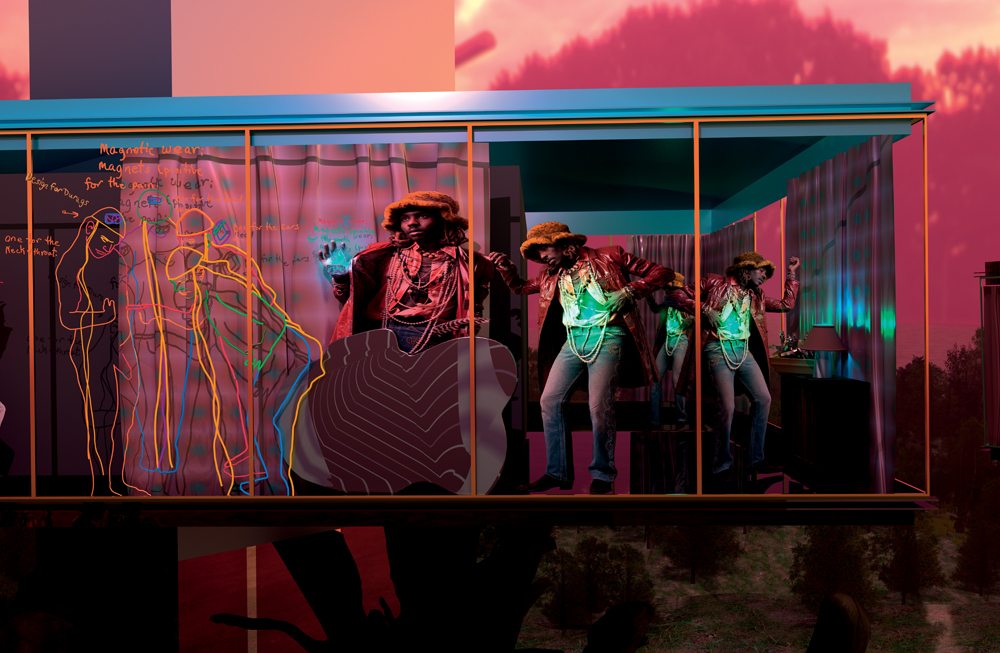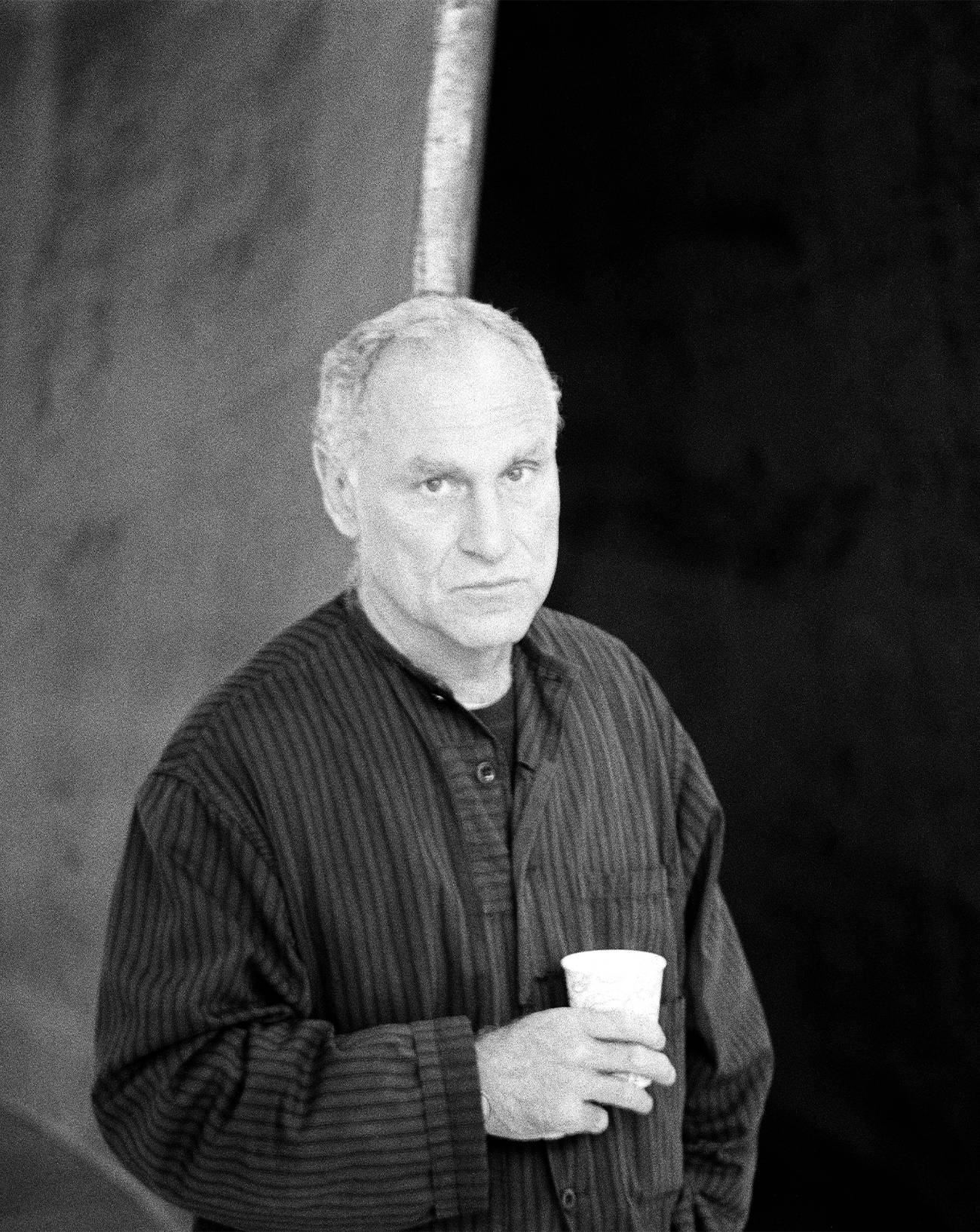

Although he has developed an ultra-contemporary digital aesthetic, Jacolby Satterwhite has always been fascinated by the Renaissance masters and art history in general. For him, the musician and producer Dev Hynes represents the new, Internet-age Renaissance man par excellence, an artist of multiple talents, visages and media.
Numéro art: Jacolby, for this edition of the magazine, you’ve teleported Dev Hynes into a baroque virtual re- ality, one of your hybrid digital creations that’s some- where between Hieronymus Bosch and cyberpunk.
Jacolby Satterwhite: Our era could be seen as a new Renaissance, in that one person’s creativity can be ex- pressed, like in the 14th and 15th centuries, in all sorts of fields: science, dance, music, technology, visual arts, etc. Dev is the incarnation of this new Renaissance man – he expresses his creativity in such a wide variety of ways. Each of my compositions develops and revisits the aesthetic of the Renaissance and the Baroque through a multitude of viewpoints, and each scene expresses the way Dev symbolizes a given aspect of today’s culture. A musician, a producer and a filmmaker, he has also sung in an indie rock band like Test Icicles and danced with Charlotte Gainsbourg in a video (Deadly Valentine). Dev has also written and pro- duced for Mariah Carey, Kylie Minogue, Mac Miller and ASAP Rocky. His practice fits perfectly with our postmodern millennial era. Ultimately, this project is a bit like a modern version of Raphael’s The School of Athens: Dev’s different personalities replace the major figures of ancient thought, but without Raphael’s grandeur. [Laughs.]


You told me during the shoot that Caravaggio’s The Incredulity of St. Thomas was also a reference.
JS: It’s an allegory of scepticism and doubt. It’s a painting that’s been with me all my life. As a child, I had to battle against illness, two cancers... I was told I was going to lose my right arm... My arm is still here, and I overcame these hardships. So why am I obsessed with this Caravaggio? Because I’m still sceptical about my own mortality. I survived. I experienced a resurrection. And I became obsessed with the idea of creating, of doing things. Producing art is a way of leaving a legacy and of remaining alive.
Dev Hynes: The Incredulity of St. Thomas is one of my favourite paintings too. My parents were Methodists, and I’ve always had an appreciation for religious imagery. It forms metaphors that permeate my music. The lyrics on my track Augustine [released in 2016 under his stage name Blood Orange] come from confessions. This can even be perceived in my melodies. I always have an eye on religious music, Puccini’s in particular. My approach to religion has evolved over the years. To start with I was more interested in religious thinking than in how people live their faith. And then I looked at the origin of religions, how they’ve stood the test of time and been used and reinterpreted absolutely everywhere, from England to Africa.
JS: The Incredulity of St. Thomas was painted as propaganda, to encourage people to take up religion, because that was the only way you could be saved. There could only be one Christian community. In the age of the Internet – which in the end is just as baroque – people now have a multitude of options, and take refuge in their chosen community. It’s an apocalyptic vision: the return to ideological divisions and racism. Everyone chooses their camp, producing pockets of extremism. I’ve also noticed that the crystallization of the Internet has been accompanied by the return of rites. Words and acts are codified. It’s the return of religion by other means. My instinct pushes me to examine these different feelings that are at work: a new solemnity, new rites, the multiplicity of communities, and this other new belief, that everyone can be an artist on the net. Talent has become a strange notion to say the least.
DH: We’re both part of the last generation that grew up before all of this even existed. And you’re right, the Internet has profoundly changed ideas about talent, success, and what it means to be an artist. Let me tell you a true story that happened to me last year. I was looking for a support act for my tour, and I was told about this group that had 3 million followers! But I bet you you’ve never heard of them. And that figure wasn’t at all reflected in their sales. But because they had 3 million followers, they demanded a fee that I simply couldn’t pay them. I had a hard time following that, mentally. Perhaps it’s because our generation was structured differently and we grew up without looking at ourselves in the mirror of social networks.
JS: We’re living in the Internet age but we still have an understanding from the analogue era. When you were a kid, pre-Internet, how did you learn to play music? Which instruments did you play?


DH: I started piano lessons when I was seven. Then as a teenager I began playing the guitar, followed by bass guitar and after that drums. I went from classical to heavy metal. [Laughs.] It was only much later that I understood how classical and metal are in fact identical.
JS: I spent my days watching MTV and I hated metal. In the early 1990s all you heard was AC/DC or Pearl Jam. I started to get it more in the 2000s when metal was transformed by groups like Korn. Then I learned to love all of it. Do you think you could release a piece of metal today? DH: Probably. I think I can do any type of music. That’s kind of like my problem.


Dance is another of your shared passions. Jacolby, you asked Dev to make some very precise gestures during the shoot. How important is movement of the body in this project, and in your work in general?
JS: Artists like Anne-Teresa De Keersmaeker and William Forsythe have really inspired my work – free, minimalist gestures, something so small, so banal... I like to imagine movements as haikus. The body becomes an abstract form, a bit like a Henry Moore. Dev makes movements that belong to him alone, and that’s what I wanted to capture here. They would look completely flat if they were done by someone else. Dev, I have to tell you that I absolutely love your video for Better Than Me with Carly Rae Jepsen. The way you move your body... In fact that video reminds me of Charles Atlas’s film Hail The New Puritan [a docufiction about the dancer and choreographer Michael Clark, made in 1985 with the help of the performance artist Leigh Bowery]. Like any queer artist, I dream of directing my own Hail The New Puritan, of managing to entwine modern life like that into an imaginary universe of pure fantasy.










